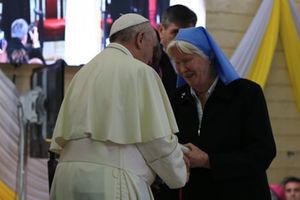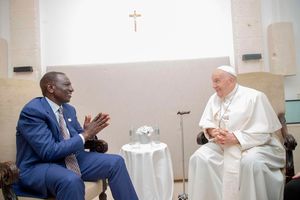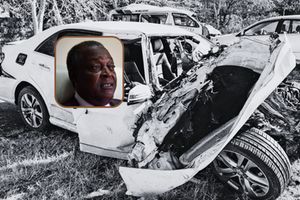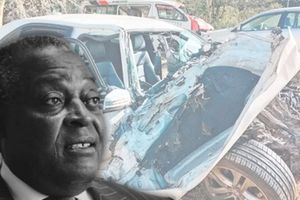
Pope Francis celebrates Mass at the University of Nairobi on November 26, 2015. He was the third pope to visit the continent.
The Roman Catholic Church considers Jesus’ disciple, Peter, as its first Pope. Pope Francis, who died on Monday, was the 266th.
From the first Pope to the 266th, lie thick layers of history, where leaders of the church have had to grapple with various issues.
Tasked with deciding the position of the church on various issues, the Pope is the bishop of Rome, Italy, and the leader of the tiny country called Vatican City, which is within Rome’s borders. Vatican City is the world’s smallest independent state.
Each Pope steered the course of history in his own way. For instance, it was the 217th pontiff, Leo X, who excommunicated Martin Luther and set the motion of the birth of the protestant movement. The 226th Pope, Gregory XIII, is known for reforming the calendar. The 107th Pope, John VIII, was the first pontiff to be assassinated.
The history of Pope Francis – whose tenure that began on March 13, 2013 until his death at 7.35 am Italy time on Easter Monday 2025 (8.35am Kenyan time) – is still being written, and Kenya can claim a share in it.
Kenya was the first African country he visited while in office. He was only the second Pope to visit Kenya. Pope John Paul II, the 264th Pope, visited Kenya three times in his 26-year tenure: in 1980, 1985, and 1995.
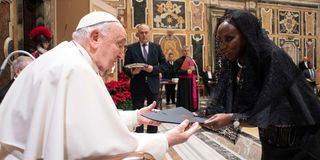
Kenya’s Ambassador to the Holy See, Ms Betty Cherwon, presents her credentials to the Pope at the Vatican on December 7, 2024.
In Nairobi, a structure along Uhuru Highway will be a permanent reminder of Pope Francis’s visit. That is the papal dais that was constructed on the University of Nairobi (UoN) grounds and from where he led a Mass that was attended by thousands and watched by millions more.
The UoN’s corporate affairs director, Mr John Orindi, told Nation.Africa that the structure is nowadays used for special prayers.
“It is still being used as a holy ground for the faithful to pray for peace. The last time we also prayed there for national peace was in 2022, when we were going for the elections,” said Mr Orindi.
Mr Orindi added that the structure has since been gazetted as a national monument. The gazettement notice was issued in 2021 by the then Heritage Cabinet Secretary Amina Mohamed.
“The dais was constructed and designed by Tectura International, an international architectural and design firm, and was used as the podium for the Pope’s Mass and address to thousands of Christians during his 2015 visit Kenya. The project, undertaken as a quick six-week programme, facilitated the Catholic Mass by the Pope and a special address to the faithful in an event that drew one million pilgrims,” said a 2021 press statement by UoN.
“The Papal dais, situated on the edge of the playing fields, evokes similar symbolism as evident in all University of Nairobi buildings: the similar symbolism is the open book motif,” it added.
Besides the structure, Mr Orindi has more to remember about the visit.
“That was the first time we had a Pope saying prayers at the University of Nairobi. It was very historic,” he said. “And the message was very, very touching: that we are diverse but we need to be tolerant to each other.”
A quick inference one may draw from the UoN story is the fact that Pope Francis was a lecturer at some point in his life—teaching literature and psychology.
His biography on the Vatican website says that he taught those two disciplines at Immaculate Conception College in Santa Fé. In 1966, it adds, he taught the same at Colegio del Salvatore in Buenos Aires.
Buenos Aires, the capital of Argentina, is where Pope Francis was born on December 17, 1936. For starters, Francis was not his birth name. At birth, he was named Jorge Mario Bergoglio; a son of Italian immigrants.
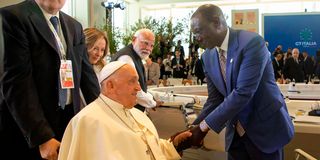
President Willliam Ruto with Pope Francis at the 50th G7 Summit, in Apulia, Italy on June 14, 2024.
He chose the name “Francis” after white smoke billowed from the Sistine Chapel in 2013, showing the world that a new pontiff had been elected.
Why “Francis”? No Pope had used the name before, but he saw it as the most appropriate.
“He took the name ‘Francis’ in honour of Francis of Assisi, the saint associated with peace, concern for the poor, and respect for the environment,” Reuters reports.
The visit to Kenya in November 2015 opened the door for three tours he would have into the continent. On the first tour, he visited Kenya, Uganda, and the Central African Republic.
He would return to Africa in 2017 when he visited Egypt. He had another prolonged tour of Africa in September 2019 when he visited Mozambique, Madagascar, and Mauritius. In March 2019, he also visited Morocco.
In his third tour between January and February 2023, he visited South Sudan and the Democratic Republic of Congo.
A relook at the message he told Christians during that Mass at the UoN grounds in 2015 reveals the virtues he wanted humanity to embody.
“[The] Kenyan society has long been blessed with strong family life, a deep respect for the wisdom of the elderly and love for children. The health of any society depends on the health of its families,” he said.
Great values
He also had a message for the UoN students: “In the heart of this university, where the minds and hearts of new generations are being shaped, I appeal in a special way to the young people of the nation. Let the great values of Africa’s traditions, the wisdom and truth of God’s word, and the generous idealism of your youth guide you in working to shape a society which is ever more just, inclusive and respectful of human dignity.”
He became a priest at 33, after working as a bouncer in Buenos Aires at some point, and so he knew quite well what the motions of youth would lead to.
He joined the seminary in 1958 at the age of 22.
“He completed his studies of the humanities in Chile and returned to Argentina in 1963 to graduate with a degree in philosophy from the Colegio de San José in San Miguel,” says his biography on the Vatican website.
It is after that degree that he taught literature and psychology.
He was ordained on December 13, 1969. He became a bishop in 1992, an archbishop in 1998 and Cardinal in 2001.
At that instance, the Vatican biography reports, Pope Francis’ love for simplicity was in full swing.
“He asked the faithful not to come to Rome to celebrate his creation as Cardinal but rather to donate to the poor,” it says.
The biography cites Pope Francis’ often-said message: “My people are poor and I am one of them.”
He used to cook his own supper as bishop and when he became Pope, he chose to stay at the Vatican hotel and not in the Apostolic Palace.
“[He] travels in small Fords or Fiats, not fancy SUVs,” the Associated Press (AP) reported in November 2024.
In fact, the article by the AP was about his revision of burial traditions, where he had stipulated that upon his death, he would like a simple ceremony to follow.
Pope Francis had indicated that he would like to be “buried in Santa Maria Maggiore Basilica in Rome, not in the grottoes underneath St Peter’s Basilica where most Popes are buried,” according to the AP.
Pope Francis was a man of many firsts, as the National Geographic wrote on Monday.
“He was the first man from outside of Europe to become Pope in more than 1,200 years, the first supreme pontiff from South America, and the first member of the Jesuits to preside as bishop of Rome,” it wrote.
“He will be on view in a simple coffin, and the burial no longer requires the traditional three coffins made of cypress, lead and oak,” it added.
Pope Francis had no shortage of issues to navigate. Among them was the divide between conservatives and liberals in the church. During his time, he introduced a number of changes that irked conservatives.
For instance, in 2016, through a document on family life, he urged priests “to be more accepting of divorced or remarried Catholics and to welcome single parents and [gay] people” as reported by Reuters.
In 2021, he overturned decisions of his two predecessors and re-imposed restrictions on the old-style Latin Mass preferred by traditionalist Catholics. Reuters described this as a “blow to conservatives”.
“Under his watch, an overhauled Vatican constitution allowed any baptised lay Catholic, including women, to head most departments in the Catholic Church's central administration,” Reuters further reported of his liberal strategy.
“Conservatives were unhappy with the Pope from the start because of his informal style, his aversion to pomp and his decision to allow women and Muslims to take part in a Holy Thursday ritual that previously had been restricted to Catholic men,” the agency added.
Pope Francis was first admitted to hospital in 2023 with a respiratory infection.
The Vatican website keeps a record of all the sermons Pope Francis gave, including the one he delivered in Nairobi. Nation.Africa’s analysis showed that the last statement he read by himself was issued on February 9. He read a few paragraphs before he let an official complete it.
In the very last message he read by himself before he delegated the role to others, he preached the message of humility.
“Jesus is not concerned with showing off to the crowds, with doing a job, with following a timetable in carrying out his mission. On the contrary, he always makes it his priority to encounter others, to relate to them, and to sympathise with the struggles and setbacks that often burden hearts and take away hope,” he said during Mass at Saint Peter’s Square.

Nine subsequent homilies he prepared after the February 9 one – including the one for Easter Sunday where he asked Christians to look for Jesus without ceasing -- were read by one cardinal or another.
With his death, the chapter closes on the 13-year reign of a Pope who did not like largesse and whose tenure saw the Roman Catholic Church issue several apologies.
He is on record as asking for forgiveness at least five times: in 2017 over clergy who sexually abuse children; in January 2018 due to his handling of a case where a bishop was accused of sex crimes against minors in Chile; in August 2018 over child abuse claims in Ireland; in 2019 in Romania over the mistreatment of the Roma People by the Roman Catholic Church; in 2022 in Canada over sexual abuse against indigenous children at schools.
In Kenya, his 2015 message will reverberate in the minds of attendants for years: “May Jesus, the Good Shepherd, the rock on whom we build our lives, guide you and your families in the way of goodness and mercy all the days of your lives. May he bless all Kenyans with his peace.”



